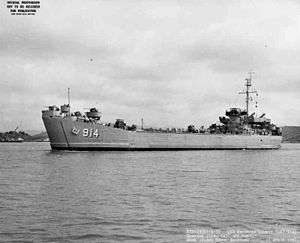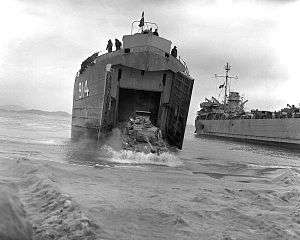USS Mahoning County (LST-914)
 Forward port quarter view of USS Mahoning County (LST-914) off Mare Island, 16 October 1957. The ship was undergoing repairs at Mare Island from 6 February to 22 December 1957. | |
| History | |
|---|---|
| Name: | USS Mahoning County (LST-914) |
| Namesake: | Mahoning County, Ohio |
| Builder: | Bethlehem Steel, Fore River Shipyard Annex |
| Laid down: | 16 February 1944 |
| Launched: | 18 April 1944 |
| Commissioned: | 18 May 1944 |
| Decommissioned: | 5 September 1959 |
| Struck: | Unknown |
| Honours and awards: | Eight battle stars |
| Fate: | Sold for scrapping |
| General characteristics | |
| Class and type: | LST-542-class tank landing ship |
| Displacement: |
|
| Length: | 328 ft 0 in (99.97 m) |
| Beam: | 50 ft 0 in (15.24 m) |
| Draught: | 8 ft (2.4 m) fwd; 14 ft 4 in (4.37 m) aft (full load) |
| Draft: |
|
| Propulsion: | Two General Motors 12-567 diesel engines, two shafts, twin rudders |
| Speed: | 16 knots |
| Range: | 5000 |
| Complement: | 7 officers, 104 enlisted men |
| Armament: | |
| Notes: |
|
The USS Mahoning County (LST-914) was an LST-542-class tank landing ship built for the United States Navy during World War II. Named after Mahoning County, Ohio, she was the only U.S. Naval vessel to bear the name.
Originally laid down as LST-914 by the Bethlehem Shipyard annex in Hingham, Massachusetts, adjacent to Fore River Shipyard on 16 February 1944; launched 18 April 1944; and commissioned 18 May 1944 with Lieutenant A. W. Meyer in command.
World War II
LST‑914 first engaged in combat duty with the invasion of southern France 15 August 1944. She carried Army troops and equipment from Naples, Italy and unloaded them on the beach near Cape Lardier. Shortly afterward the LST joined Training Group Command, Atlantic Fleet, and operated along the east and gulf coasts until early in 1945. On 10 February 1945, she departed Gulfport, Mississippi, for the Canal Zone en route to duty with the Pacific Fleet. Steaming via Pearl Harbor and Eniwetok, she arrived Saipan 25 April. For the next 4 months the ship carried men and equipment between Saipan and Okinawa, making occasional calls at Tinian and Guam. She departed Saipan 24 July and sailed for the Philippines, operating there for the remainder of the War. LST‑914 continued to operate in the Western Pacific after the Japanese surrender. On 26 June 1946 she decommissioned and was lent to the United States Army. She was then given a Japanese crew and for the next 4 years transported general cargo in the Far East.
Korean War
With the outbreak of hostilities in Korea and the consequent urgent need for ships, LST‑914 recommissioned at Yokosuka, Japan 26 August 1950 with Lieutenant R. L. Holzhaus in command. By 6 September she was steaming for the combat zone. She embarked units of the 1st Marine Division at Pusan and transported them around the peninsula for the 15 September Inchon invasion, one of the decisive amphibious assaults of history, which routed the North Korean Army. Following Inchon, for which her task element was awarded the Navy Unit Commendation, the LST participated in the Wonsan operations and in the evacuation of Hungnam, 10–24 December. On 13 January she sailed for Kobe, Japan, underwent overhaul and returned to Korea in mid‑February. She continued to support operations off the Korean coast until 1 April 1951, then departed for San Diego, arriving 26 May.
Post-War duty
For the next 2 years LST‑914 operated off the West coast. In June 1953, she departed San Diego for her first Bar‑Change operation, the replenishment of bases in the Arctic. She returned to that duty during the summers of 1955‑1957 and plied the waters of the Arctic Ocean, operating primarily in the Beaufort Sea. En route to her 1955 Arctic deployment, LST‑914 was given the name USS Mahoning County (LST-914) in ceremonies at Seattle, Washington 7 July. Among the sailors on board was Fireman Richard G. Adams of Struthers, Ohio, a city in Mahoning County. In addition to her Arctic cruises, the LST also participated in deployments in the western Pacific during the winters of 1954, 1956, and 1958. In 1958, the Mahoning County was awarded the Marjorie Sterrett Battleship Fund Award, which is presented annually by the U.S. Navy's Chief of Naval Operations to the fleet's most battle-ready ship. Mahoning County operated out of Long Beach for the first 9 months of 1959. On 5 September she decommissioned and was sold to Zidall Explorations, Inc. of Portland, Oregon on 22 June 1960 for scrapping.

LST‑914 received two battle stars for World War II service and six for Korean War service.
References
This article incorporates text from the public domain Dictionary of American Naval Fighting Ships.
- "Mahoning County". Dictionary of American Naval Fighting Ships. Retrieved 13 August 2007.
- "LST-914 Mahoning County". Amphibious Photo Archive. Retrieved 13 August 2007.
